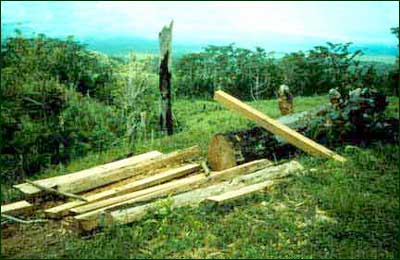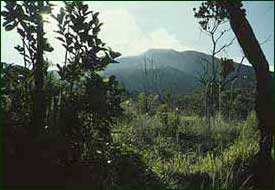Discovering Diversity
This site is under redevelopment. Its content is from 1998, but we will be updating it in the near future.
A celebration of an endangered habitat
When a typhoon hits Mount Isarog directly, up to a meter of rain can fall in a day, but the high mountain forests of Mount Isarog function as a gigantic sponge, soaking up the heavy rains and releasing the water slowly into the groundwater system. This natural water-control system prevents floods, but it also prevents droughts by gradually releasing water throughout the year into springs, streams, and rivers, even during the two-to-four-month dry season that occurs in the lowlands each year. The Isarog shrew-rat, the earthwormsit eats, and the habitat in which they live all form part of the network of mountain rain forests that supplies one of the most critical needs of the human societies that also live in the area—clean, steadily-flowing water.
On breezy days during our field studies on Mount Isarog in 1988, we could hear only the sounds of neighboring birds and frogs, as the sighing of the wind in the trees covered other sounds from farther away. On days when the wind was still, from dawn to dusk we were serenaded by a different sound—the roar of chain saws and the crashing of trees echoing to us from lower on the slopes. We heard a dozen or more big trees being felled and cut each day, rumbling like thunder in the distance. When we visited the sites where the cut trees lay, we found young subsistence farmers, who had rented a chain saw from a local businessman with the promise to deliver timber to the nearest road, where a truck would pick up the wood. The truck would climb the mountain into the national park every few weeks, pick up lumber from enough locations to make a full load, then haul it to Naga City under the cover of darkness. We were told that at the check-points set up by governmentagencies and police, payments were made to assure that everyone received a share from the illegal logging, and the next day beautiful hardwood lumber was available at the hardware store owned by a relative of a prominent local politician. After paying for the loan of the chain saws, the subsistence farmers who did the difficult and dangerous work of cutting the trees received the equivalent of a few dollars per day, and those receiving payoffs, who did nothing but look the other way, received enough to extend their meager salaries. Most of the proceeds from the logging went to the family of the businessman and politician. Of course, none of the proceeds went for park management or reforestation.


